WYOBIO HANDBOOK A GUIDE TO WEED BIOLOGICAL CONTROL IN
WYOBIO HANDBOOK A GUIDE TO WEED BIOLOGICAL CONTROL IN
WYOBIO HANDBOOK
WYOBIO HANDBOOK

A Guide to Weed Biological Control in Wyoming
WYOBIO Handbook
a Guide to Weed Biological Control in Wyoming
compiled by:
Timothy Collier
University of Wyoming
Department of Renewable Resources
with contributions from:
Lars Baker, Fremont County Weed and Pest
Steve Brill, Goshen County Weed and Pest
Brian Connely, Natrona County Weed and Pest
Rich Hansen, USDA APHIS PPQ
Jeff Littlefield, Montana State University
Scott Nield, Lincoln County Weed and Pest
Brett Richardson, Teton County Weed and Pest
Dick Sackett, Crook County Weed and Pest
Nancy Webber, Fremont County Weed and Pest
TABLE OF CONTENTS
Introduction
Canada Thistle Agents
Ceutorhynchus litura 3
Urophora cardui 3
Musk Thistle Agents
Trichosirocalus horridus 5
Dalmatian Toadflax Agents
Mecinus janthinus 7
Field Bindweed Agents
Aceria malherbae 9
Spotted/Diffuse Knapweed Agents
Larinus minutus 11
Bangasternus fausti 11
Agapeta zoegana 13
Cyphocleonus achates 15
Sphenoptera jugoslavica 17
Leafy Spurge Agents
Aphthona lacertosa 19
Aphthona nigriscutis 19
Spurgia esulae 19
Introduction
The goal of this handbook is to provide concise guidance on the practice of weed biological control in the state of Wyoming. The focus is how to collect, release and identify weed biological control agents that are either thought to be somewhat effective in Wyoming and/or being actively distributed at the time this handbook was written. “Effectiveness” might be based on science or basic experience of those working with the insects in the field. Certainly, not all agents present on all weeds in Wyoming are discussed though there is mention and photos of a few species that might be confused with the species that are considered.
The intended audience for the book include Wyoming Weed and Pest employees, ranchers, land managers and government employees; anyone with an interest in biological control but not necessarily an advanced degree in entomology. Above all, it is hoped that the handbook serves as a quick reference that fits in the glove box of a pick up. More information can be found in the “Biological Control of Weeds of the West”. This great reference provided a good deal of the information given here. Additional information on weed biological control in Wyoming can be obtained by directly contacting your county’s Wyoming Weed and Pest supervisor. If he or she cannot help you, then he or she undoubtedly can put you in touch with some one who can. The Weed and Pest supervisors are a great resource, and much of the useful information provided here came from the supervisors listed above.
How to Use this Guide
The same information is given for each agent. The first two categories don’t need further explanation. “Agent Size” is a maximum approximate size. Individual agents will vary in size depending on their environment, and of course will also grow during the juvenile stages. They can be smaller than the figure given. “How and When to ID” is meant to assist in determining whether a given agent has become established at a site where it has been previously released. It is important to note that it may take a year or more for agent numbers to build up to detectable numbers. In addition, it is also possible that agents moved from the release site (often marked with a T-post) and are doing well a few yards away. “How and When to ID” also gives the stage of the agent that is easiest to find and/or distinguish from other similar agents. You may find different stages than the one indicated. If you keep looking the correct stage will probably turn up to confirm the identification. “How and When to Collect” gives approximate times of year and suggested techniques for collection (see Recommended Equipment and General Procedures for more information). “What to Release” suggests the stage and number of agents to release per site. Its worth noting that some people think that more is better and leads to quicker control. This is certainly sensible, though small releases can eventually lead good control and is an OK strategy if very few agents are available. Finally, ”Where to Release” is a guideline based mostly on experience. It may be worth trying to release at sites that don’t fit the specific criteria.
Recommended Equipment and General Procedures
A list of equipment useful for practicing biological control of weeds is given below in Table 1. It is worth emphasizing that the most important step in the process is transportation, and the most important piece of equipment for any agent is a cooler with some kind of ice pack(s). All agents should be transported in a cooler, within paper containers with lids or in some cases, soda cups with plastic lids. All plastic containers and plastic bags are a bad idea; the insects will “cook”. Ideally, some way of securing the cups or containers should be used to keep things from rolling around inside the cooler. In addition, the sooner the agents are released the better. One to two days maximum should be the goal. Releasing in the morning or evening and/or in the shade is also often the best strategy. Finally, when adult beetles are transported, they need weed foliage to feed on. Aphthona beetles in particular will eat a tremendous amount of leafy spurge foliage, so include as much as possible.
Collecting is also of course an important step. For many agents, a number of different techniques may work well. Sweep netting is a common collecting technique that is used especially on adult beetles. It can be frustrating when insect numbers are low, however. In these scenarios, it may be more productive to simply catch the agents by hand or with blunt tweezers. Other possibilities are to: suck up the agents with an aspirator, tap the agents directly into a paper cup, or beat the plant over a (white) bucket. Gall-formers and stem-miners can be collected while still in the plant and simply moved to the new site with the plant material. Parasites of the agent might also end up at the new release site using this approach but parasites are not usually important. Lastly, moth agents are typically collected using a black light and a white sheet at night, ideally on a night with a wane moon or before the moon comes up.
Table 1. Recommended Equipment for Practicing Weed Biological Control
Cooler with ice packs
Cylindrical paper containers with lids
Assorted Sizes of soft Styrofoam blocks (to wedge between containers in cooler)
Sweep Net
Bucket
Aspirator (opt.)
Blunt (Eyebrow) Tweezers (opt.)
CANADA THISTLE AGENTS
Ceutorhynchus litura
Pronunciation: SUIT-O-RINK-US LIT-OO-RA
General Description: Stem Mining Weevil
Agent Size: about 1/10 to 1/6 inch long.
When & How to ID: in June, split the lower parts of upright stems; look for white grubs and damage (dark plant tissues, tunnelling) within the stem.
When & How to Collect: in May-June, look for feeding damage (holes) in thistle leaves; collect adults with an aspirator or blunt tweezers; in Sept., collect with a sweep net. Ideally collections should be done in the morning.
What to Release: 200 or more adults/site.
Where to Release: best in riparian areas.
Ceutorhynchus
litura Adult Photo
courtesy of USDA ARS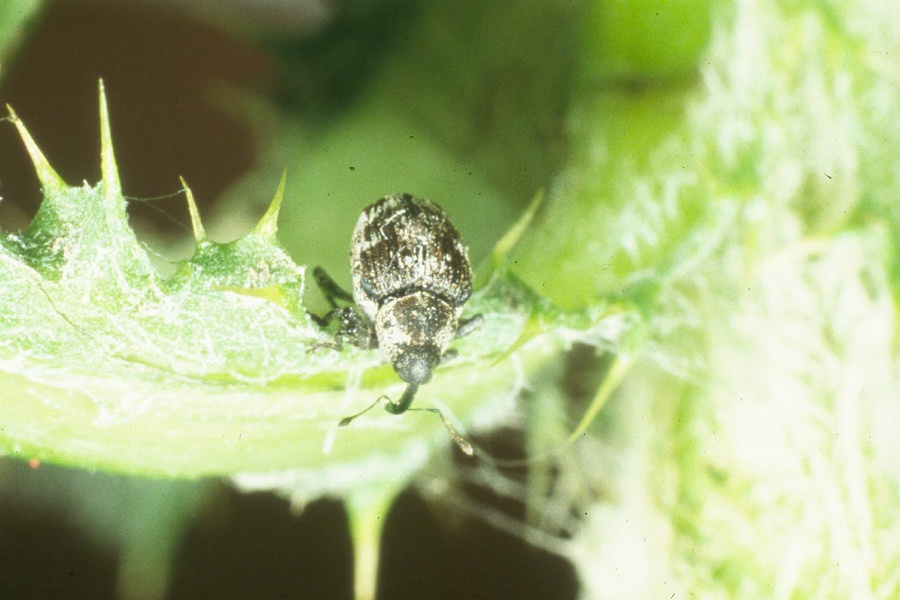
Ceutorhynchus
litura Larvae Photo
courtesy of USDA ARS
Urophora cardui
Pronunciation: YUR-OFF-OAR-A CARD-YOU-EYE
General Description: Stem-Galling Fly
Agent Size: Gall: 1-3 inches in diameter.
When & How to ID: in Sept.-Oct., look for green almond-to-walnut sized galls on upright thistle stems.
When & How to Collect: in Sept.-Oct., collect dried (brown) galls and move to new site.
What to Release: 200 or more galls/site.
Where to Release: best in riparian areas.

Urophora
cardui Gall Photo
courtesy of USDA APHIS PPQ
MUSK THISTLE AGENTS
Trichosirocalus horridus
Pronunciation: TRY-KO-SEAR-O-CAL-US HOR-ID-US
General Description: Root-Feeding Weevil
Agent Size: about 1/8 to 1/6 of an inch long.
When & How to ID: in May-June, pull up thistle plants; split roots with a knife and look for white grubs and damage in the upper part of the root (dark plant tissues, tunnelling).
When & How to Collect: in late-June-July, collect adults using an aspirator or sweep net, or by beating the plant over a bucket. This species might be confused with Rhinocyllus conicus, which is larger, has a shorter “snout” and has smooth, spotted wing covers rather than rough-looking wing covers.
What to Release: 200-400 adults/site.
Where to Release: best in dry areas.
Trichosirocalus
horridus Adult
Photo
courtesy of Jeff Littlefield,
Montana
State University
Trichosirocalus
horridus Larvae Photo
courtesy of Jeff Littlefield, Montana
State University and Forestry
Images www.forestryimages.org
Rhinocyllus
conicus Adult Photo
courtesy of Jeff Littlefield, Montana
State University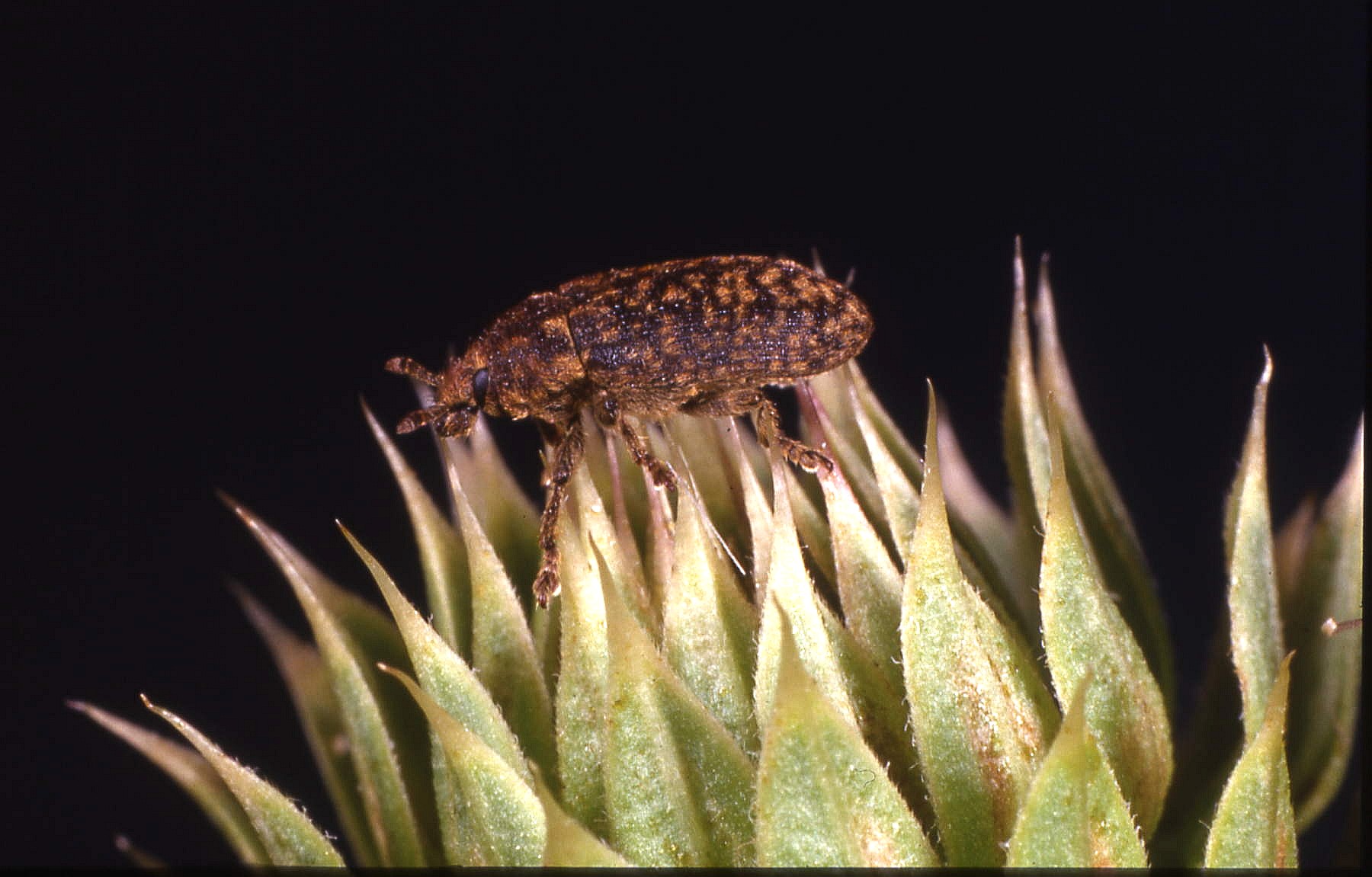
DALMATIAN TOADFLAX AGENTS
Mecinus janthinus
Pronunciation: MEH-SIGH-NUS JAN-THIN-US
General Description: Stem-Mining Weevil.
Agent Size: about 1/8 to 1/6 of an inch long.
When & How to ID: in Oct.-Nov., split dried toadflax stems with a knife; look for blue-black adult weevils and feeding tunnels within the stem; might be confused with another beetle, Brachypterolus pulicaris, which is smaller (1/10 inch long) and lacks a “snout”. Also, Brachypterolus will be concentrated in and on the flowers.
When & How to Collect: in June, collect adults from plants by knocking them into cups, using an aspirator or with a sweep net; in Oct.-Nov., collect stems and place at new release site. Collecting the adults in June is best if densities are high enough.
What to Release: 200 or more adults/site; 20-25 stems/site.
Where to Release: ideally in areas with snow accumulation.
Mecinus
janthinus Adult Photo
courtesy of USDA
APHIS PPQ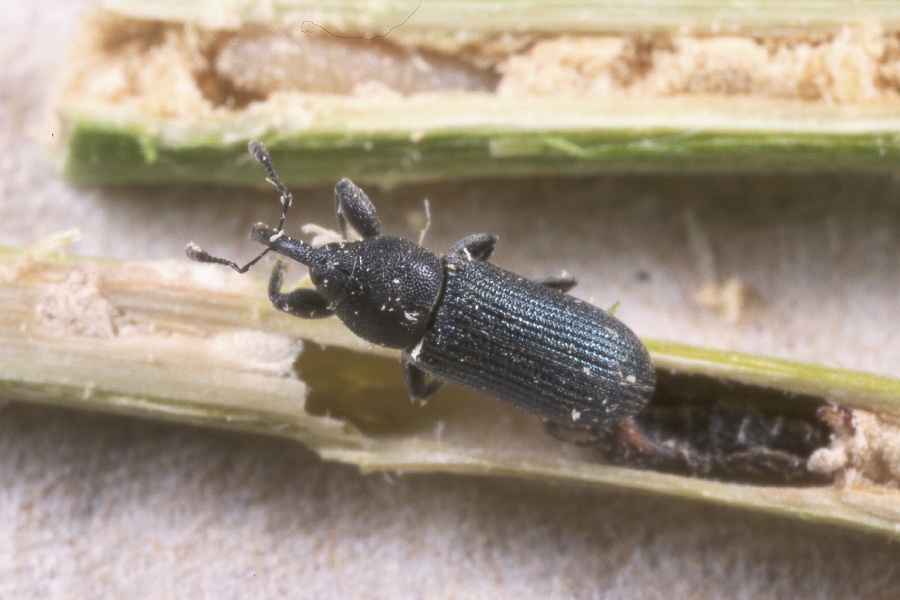
Brachypterolus
pulicarious Adults Photo
courtesy of USDA APHIS PPQ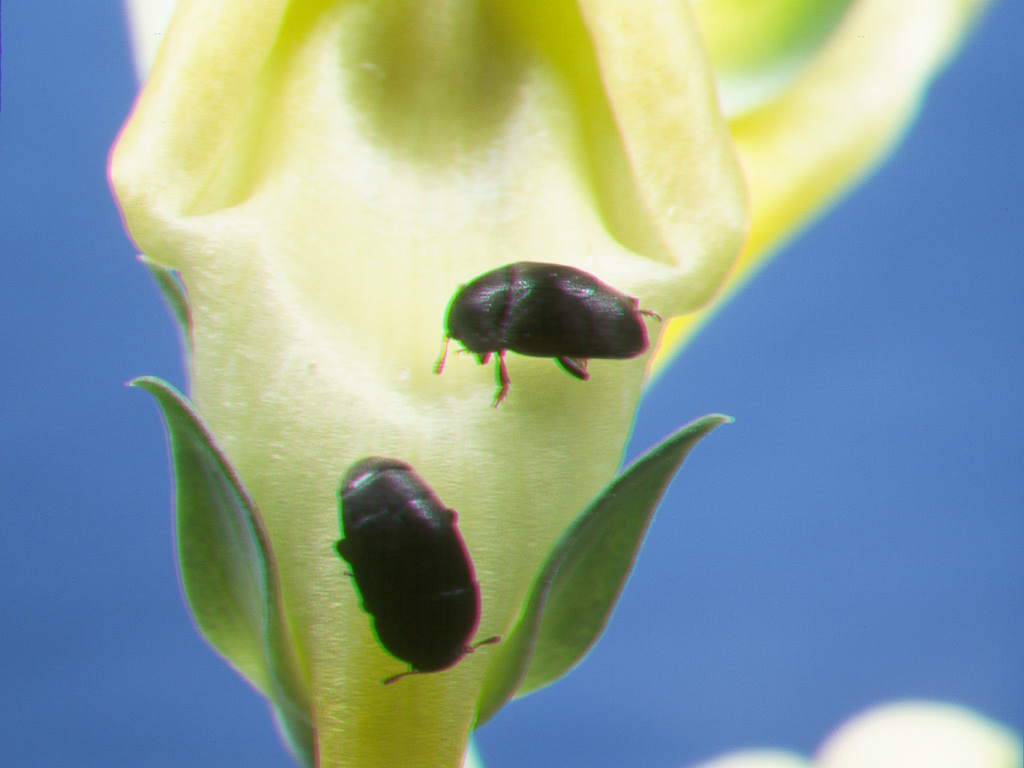
FIELD BINDWEED AGENTS
Aceria malherbae
Pronunciation: AH-SEAR-EE-AH MAL-HERB-EE
General Description: Leaf-Galling Mite
Agent Size: not visible to the naked eye.
When & How to ID: in Aug.-Sept., look for twisted, deformed leaves (galls).
When & How to Collect: in July-Aug., collect stems with deformed leaves; wrap around and under growing tips of bindweed plants at the new site.
What to Release: softball sized bundle of galled leaves/site.
Where to Release: ideally in areas that are or can be mowed.

Aceria malherbae Gall
Photo courtesy of Jeff Littlefield, Montana State University
SPOTTED/DIFFUSE KNAPWEED AGENTS
Larinus minutus
Pronunciation: LA-RYE-NUS MY-NOOT-US
General Description: Seed-Feeding Weevil
Agent Size: about 1/6 to 1/5 of an inch long.
When & How to ID: in July, look for grey-brown adults on knapweed foliage and stems; this species might be confused with Bangasternus fausti, which is far less common in Wyoming and has shorter, more club-like antennae and a shorter “snout”.
When & How to Collect: In July, collect adults from foliage by knocking them into cups, using an aspirator or with a sweep net.
What to Release: 200 or more adults/site.
Where to Release: any diffuse or spotted knapweed infestation.

Larinus minutus Adult
Photo courtesy of USDA APHIS PPQ
Bangasternus fausti
Pronunciation: BANG-ASS-TURN-US F-OW-STY
General Description: Seed feeding Weevil.
Agent Size: about 1/7 to 1/6 of an inch long.
When & How to ID: in June, look for brown adults on knapweed foliage and stems; this species might be confused with Larinus minutus, which is much more common in Wyoming, has longer antennae and a longer “snout”. Bangasternus has been released at few sites in Wyoming.
When & How to Collect: In June, collect adults from foliage by knocking them into cups, using an aspirator or with a sweep net.
What to Release: 200 or more adults/site
Where to Release: diffuse or spotted knapweed infestations in riparian areas.
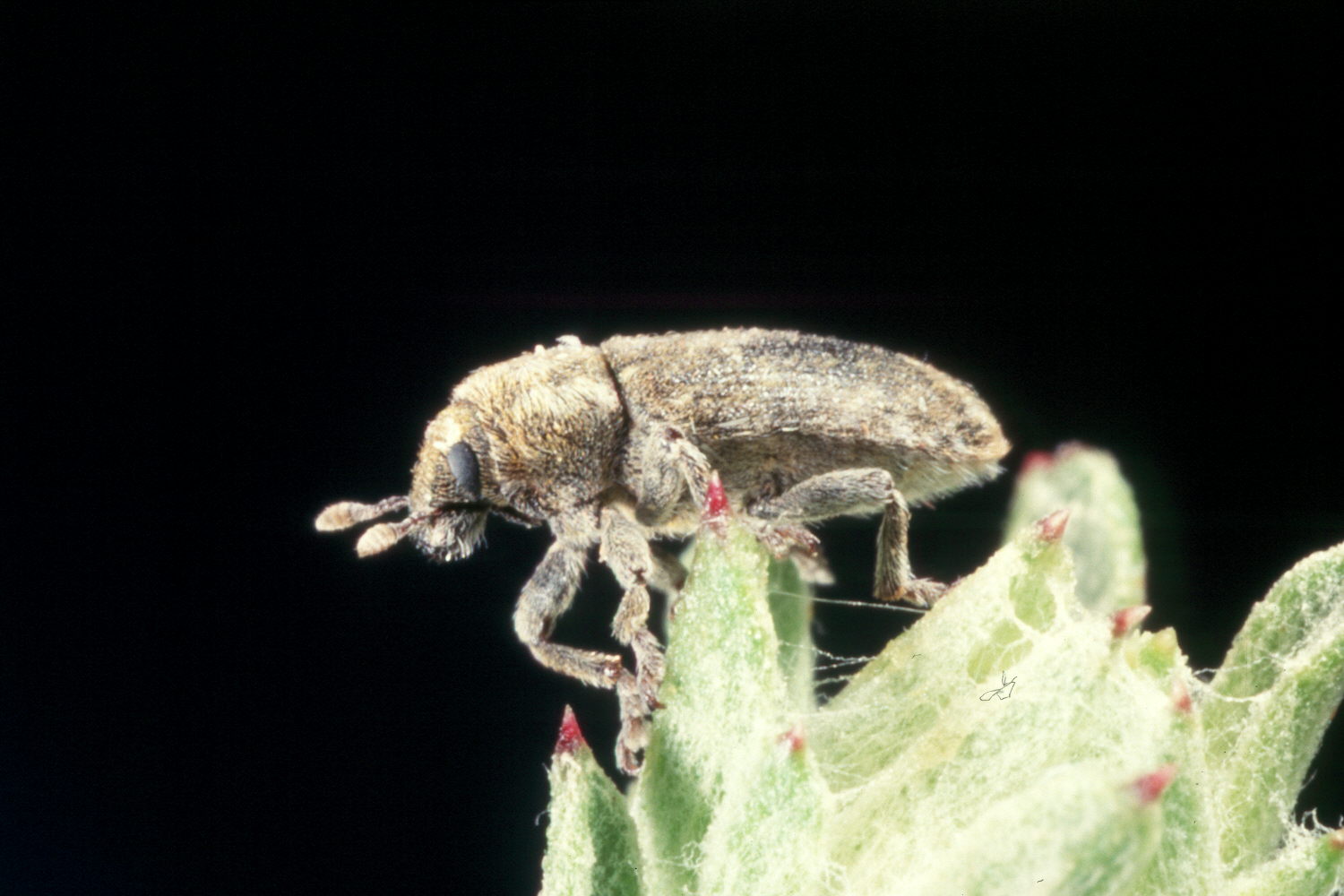
Bangasternus fausti Adult
Photo courtesy of USDA APHIS PPQ
Agapeta zoegana
Pronunciation: AG-AH-PEET-AH ZO-GAY-NA
General Description: Root-Feeding Moth
Agent Size: 1/2 of an inch long or less.
When & How to ID: in June, pull up knapweed plants (with gloves); split the roots with a knife and look for elongated grey or white larva; this species might be confused with the two root-feeding beetles on knapweeed; one of these species is similarly elongated but has an enlarged area behind the head (Sphenoptera jugoslavica); the other beetle species (Cyphocleonus achates) is “plump” and C-shaped.
When & How to Collect: in July, collect adults at night using a blacklight and white sheet, aspirating adults off the sheet.
What to Release: 200 or more adults/site.
Where to Release: any diffuse or spotted knapweed infestation.
Agapeta
zoegana Adult Photo
courtesy of USDA APHIS PPQ
Agapeta
zoegana Larva Photo
courtesy of USDA APHIS PPQ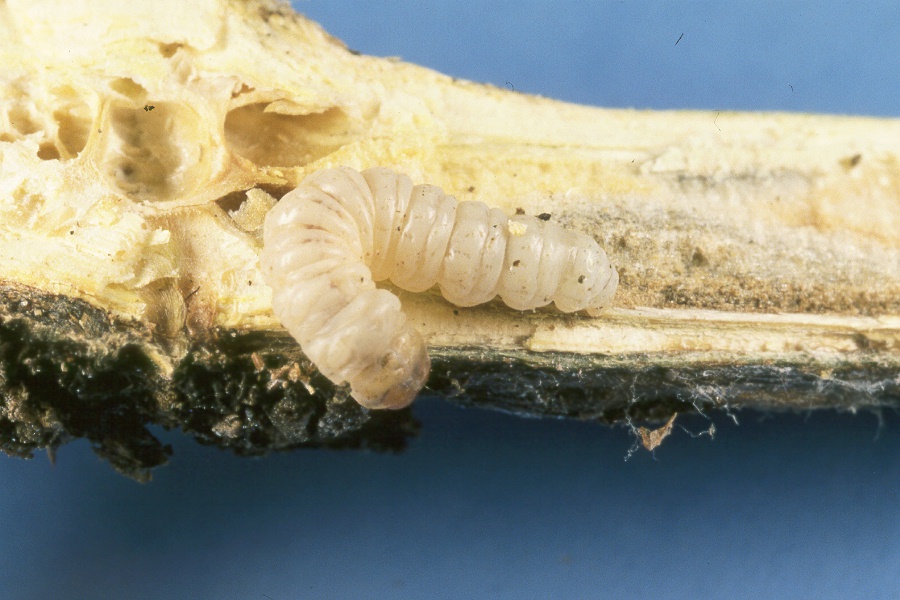
Cyphocleonus achates
Pronunciation: SIGH-FO-CLEE-OWN-US AA-KAY-TEASE
General Description: Root-Feeding Weevil.
Agent Size: 1/2 to 3/4 of an inch long.
When & How to ID: in June-mid-July, pull up knapweed plants (with gloves); split the roots with a knife or by hand and look for plump, white C-shaped grub. Other root-feeding insects will be elongated.
When & How to Collect: in early-mid-Aug., collect large red-grey or green-gray weevils from foliage by hand.
What to Release: 200 or more adults/site.
Where to Release: knapweed infestations with coarse, sandy soils.
Cyphocleonus
achates Adult Photo
courtesy of USDA APHIS PPQ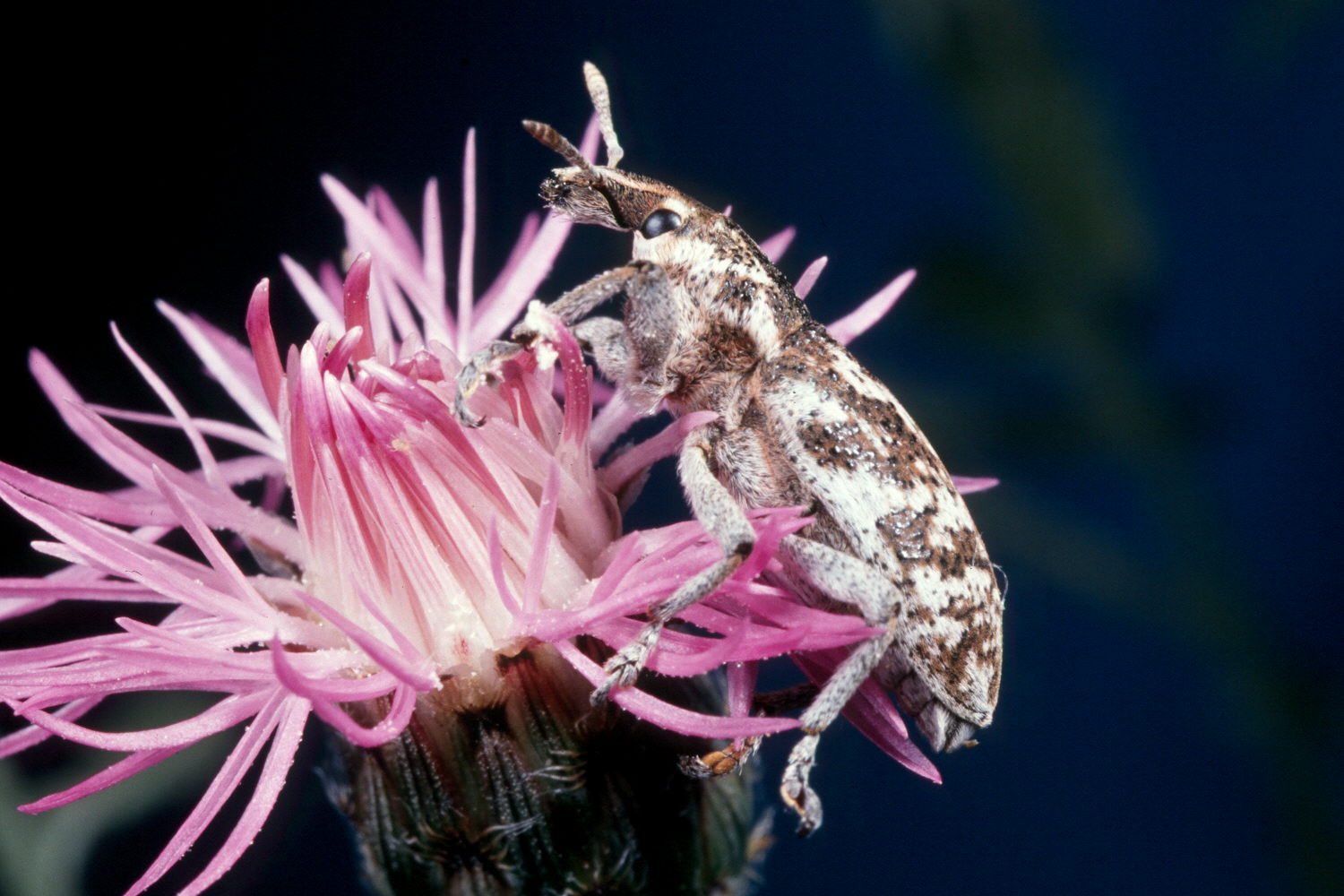
Cyphocleonus
achates Larvae Photo courtesy of USDA APHIS PPQ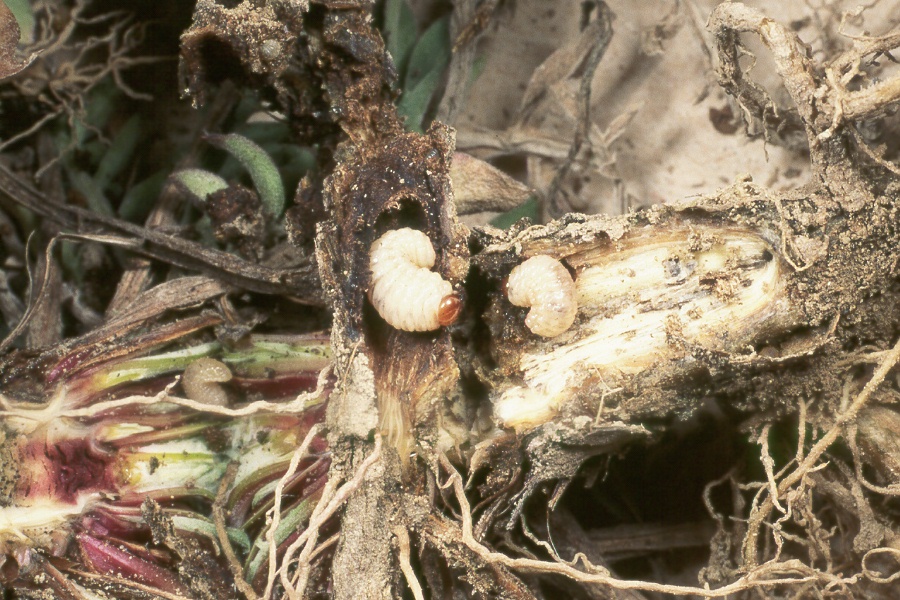
Sphenoptera jugoslavica
Pronunciation: S-FEN-OP-TUR-A YOU-GO-SLAW-VICA
General Description: Root-Feeding Beetle.
Agent Size: about 1/3 of an inch long.
When & How to ID: in July, sweep net for adults in early morning; look for bullet-shaped metallic green beetles; in late May, pull up knapweed plants (with gloves); split the roots with a knife or by hand and look for elongated grub with enlarged area behind the head. May be confused with two other root-feeding agents on knapweed. Cyphocleonus is plump and C-shaped instead of elongated. Agapeta is elongated but lacks enlarged area behind the head.
When & How to Collect: in July, sweep net for adults in early morning. Look for bullet-shaped metallic green beetles.
What to Release: 200 or more adults per site.
Where to Release: diffuse knapweed sites. Not very effective on spotted knapweed.
Sphenoptera
jugoslavica Adult Photo
courtesy of USDA APHIS PPQ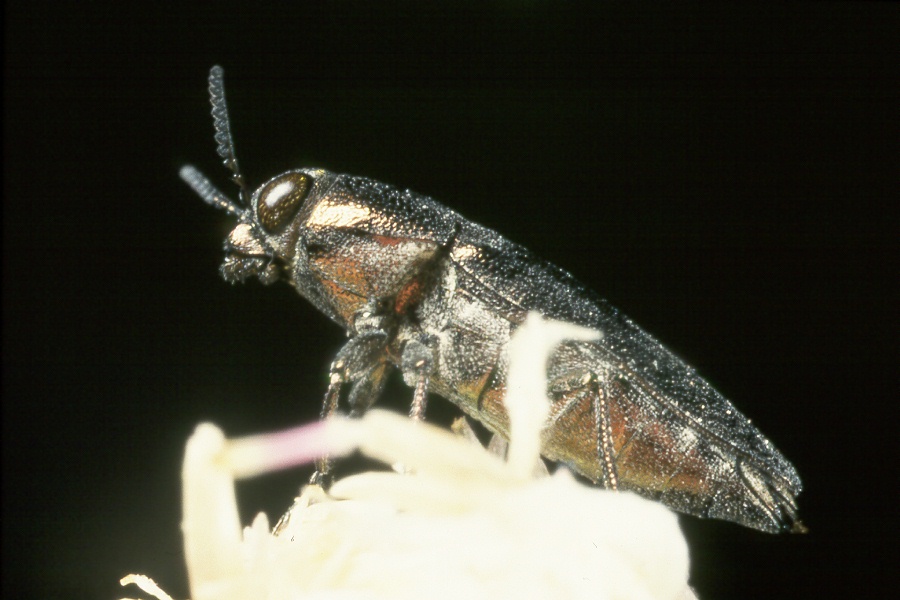
Sphenoptera
jugoslavica Photo
courtesy of USDA APHIS PPQ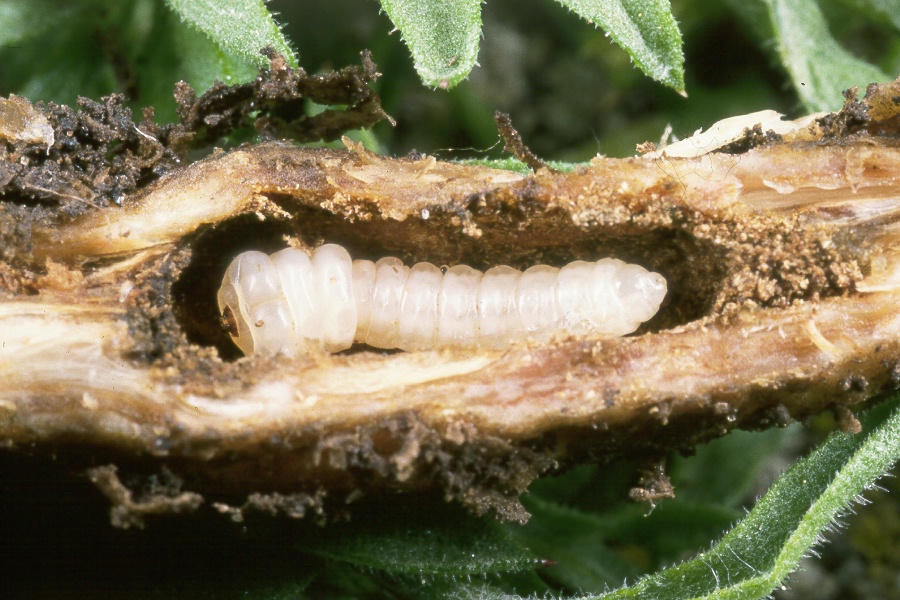
LEAFY SPURGE AGENTS
Aphthona lacertosa
Pronunciation: AP-THO-NA LASS-UR-TOES-SA
General Description: Root-Feeding Leaf Beetle
Agent Size: 1/8 of an inch.
When & How to ID: in June-late July, look for adult feeding damage on foliage (holes in leaves) and the presence of black adults; use a sweep net; look for jumping black beetles in the net.
When & How to Collect: early-July is ideal; use sweep nets to collect adults in the thousands; sweep in areas with many beetles; look for adults or sweep in areas with heavily defoliated or thinned spurge; return to sweep in productive areas; include as much spurge foliage in cups as possible for transportation.
What to Release: 3000-10,000 adults/site.
Where to Release: “mesic” areas (not too dry, not too wet); riparian areas sheltered by trees OK.

Aphthona lacertosa Adult
Photo courtesy of USDA APHISS PPQ
Aphthona nigriscutis
Pronunciation: AP-THO-NA NYE-GRI-S-CUTE-US
General Description: Root-Feeding Leaf Beetle
Agent Size: 1/8 of an inch.
When & How to ID: in June-late July, look for adult feeding damage on foliage (holes in leaves) and the presence of brown adults; use a sweep net; look for jumping brown beetles in the net.
When & How to Collect: mid-July is ideal; use sweep nets to collect adults in the thousands; sweep in areas with many beetles; look for adults or sweep in areas with heavily defoliated or thinned spurge; return to sweep in productive areas; include as much spurge foliage in cups as possible for transportation.
What to Release: 3000-10,000 adults/site.
Where to Release: south-facing hill slopes; tops of dry hills; open range; areas not sheltered by brush or trees.

Aphthona nigriscutis Adult
Photo courtesy of USDA APHISS PPQ
Spurgia esulae
Pronunciation: SPURGE-EE-YA ESS-U-LEE
General Description: Stem-Galling Fly
Agent Size: Pupae are 1/14 of an inch long.
When & How to ID: in July-Sept., look for green “bundles” of leaves (galls) on the tops of spurge plants.
When & How to Collect: in mid-July-Aug., scout by pulling open galls; when pink, fluffy looking pupae appear, collect 8-12 inch lengths of stem with galls; wrap the bottom of the stems in a wet paper towel and place in shade at the new site.
What to Release: 50-200 galls/site.
Where to Release: best in riparian areas.
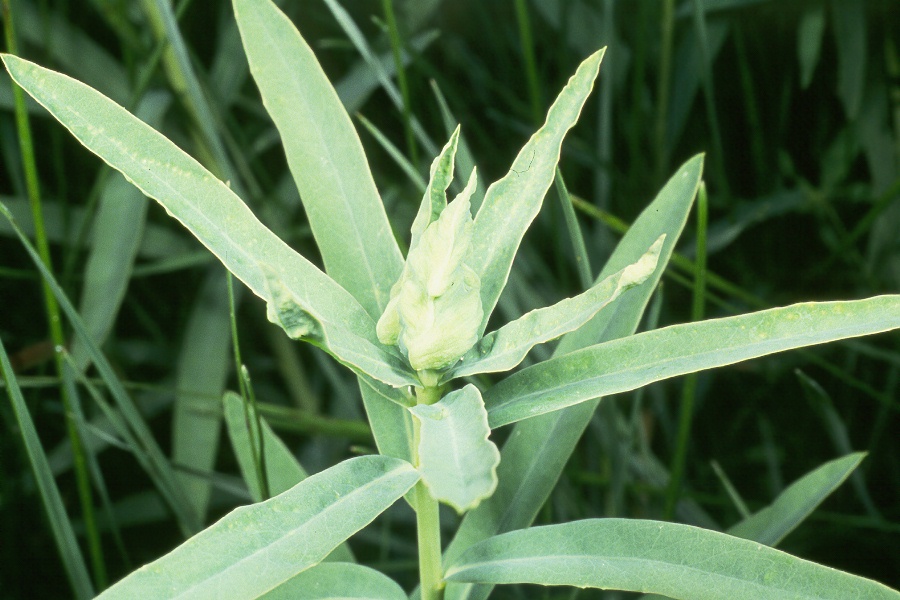
Spurgia esulae Gall
Photo courtesy of USDA APHISS PPQ
Tags: biological control, weed biological, handbook, biological, control, wyobio, guide
- A RTS INSTITUTE CODE OF ARTS INSTITUTE DECEMBER 2016
- PATROLLING ROSTER SEASON 20102011 PATROL CAPTAINS MARC PULEPULE 04
- ® CSPT ORIENTACIONS SOBRE LA UTILITZACIÓ DELS DOCUMENTS DE
- MULTICULTURALISMO EL CÁNCER DE LOS DERECHOS HUMANOS VERSUS UN
- GLOBALNA PROMJENA KLIME JEDAN JE OD NAJVEĆIH IZAZOVA ČOVJEČANSTVA
- MICROSOFT WINDOWS SMALL BUSINESS SERVER 2003 CUSTOMER SOLUTION CASE
- ANMÄLNING TILL FÖRSKOLA 2016 – 2017 JAG ANMÄLER MITT
- PLAN DE ACTUACIÓN DEL CENTRO CLÁSICOS ESCOLARES 1617 CENTRO
- 15 PENGAWAS PAI KABUPATEN GRESIK HALAMAN PENGESAHAN LAPORAN KEPENGAWASAN
- 3GPP TSGRAN3 112E R3212671 ONLINE 17TH – 27TH MAY
- VILNIAUS MIESTO 6 KL LIETUVIŲ KALBOS OLIMPIADOS DALYVIŲ REZULTATAI
- THE NOTARIES RULES 1956¹ IN EXERCISE OF THE POWERS
- JEREZ CELEBRARÁ EL LIII CONCURSO MORFOLÓGICO EQUINO COORGANIZADO POR
- ACT GOVERNMENT GAZETTE GAZETTED NOTICES FOR THE WEEK
- MAKROEKONOMIJA DEMONSTRATURE 4 1 ŠTO OD NAVEDENOG PREDSTAVLJA NAJBOLJI
- S ZIGETSZENTMIKLÓSI ÁDÁM JENŐ ÁLTALÁNOS ISKOLA ÉS AMI 2310
- INSTRUCŢIUNI PROPRII DE SECURITATE SI SĂNĂTATE ÎN MUNCĂ PRIVIND
- ATTACHMENT 1 PAGE 3 OF 3 CALIFORNIA DEPARTMENT OF
- PUBLIC HEALTH AND MEDICINE IN EMERGENCY MANAGEMENT RICHARD A
- PRESS RELEASE TARGET GROUPADEQUATE LIGHTING OF SHOP AND RETAIL
- ESPERABA QUE ELLOS (VOLVER) PARA LAS DIEZ SIEMPRE
- BACKGROUND OF CONSERVATION RELEASE BY LEN LICHVAR THE LONG
- KEMENESI KULTURÁLIS KÖZKINCS KEREKASZTAL STRATÉGIAI HELYZETELEMZÉS A KISTÉRSÉG
- ÁDVENTI IMÁDSÁG JÖJJ EL NÉPEK VÁRAKOZÁSA ÚR JÉZUS
- 01_ponasanje_u_skoli-pravila_ponasanja_u_razredu
- ATTACHMENT A WHAT ABOUT CONFIDENTIALITY OF RECORDS AND AUTHORIZATION
- ACCOUNTS RECEIVABLE INVOICE (C & I INVOICE) DUE TO
- FORM1 DERS VERMEK ÜZERE GÖREVLENDİRME FORMU ( ÖĞRETİM ÜYESİELEMANI)
- 89 BILLING ACCOUNTS RECEIVABLE NAVIGATION OVERVIEW IN MANY
- ACCOUNTS APPLICATION FORM 1 TRADING NAME REGISTERED NAME
STATYSTYKA ŹRÓDŁEM WIEDZY SPRAWOZDANIE ZE SPOTKANIA REGIONALNEGO ŚRODOWISKA
MEGBÍZÁS KÖZVETLEN KÉPVISELETRE (FOLYAMATOS) AMELY LÉTREJÖTT EGYRÉSZRŐL A SLINE
 ISTITUTO PER LA RICERCA LA FORMAZIONE E LA RIABILITAZIONE
ISTITUTO PER LA RICERCA LA FORMAZIONE E LA RIABILITAZIONEPROTOCOL ON VETERINARY MATTERS SUPPLEMENTING THE AGREEMENT BETWEEN THE
 Fragmentation of Small Carbon Clusters a Review k Béroff1
Fragmentation of Small Carbon Clusters a Review k Béroff1TOWN OF JOHNSTOWN PLANNING BOARD APRIL 13 2021 600
REPUBLIKA SRBIJA CENTAR ZA SOCIJALNI RAD BROJ IV5511375220 DATUM
 LLK – TERM S – THÈME OBSERVER – PROPRIÉTÉS
LLK – TERM S – THÈME OBSERVER – PROPRIÉTÉSTHE METRO ACADEMIES INITIATIVE INCREASING COLLEGE COMPLETION THROUGH A
 KAVČE 67 3320 VELENJE MOBITEL 041665038 EMAIL PROFILKUNSTGMAILCOM 101508
KAVČE 67 3320 VELENJE MOBITEL 041665038 EMAIL PROFILKUNSTGMAILCOM 101508 DARIO FO Y FRANCA RAME SEGÚN JUAN MARGALLO Y
DARIO FO Y FRANCA RAME SEGÚN JUAN MARGALLO YCONVENIO DE SUBVENCIÓN ERASMUS+ EDUCACIÓN SUPERIOR PARA ESTUDIOS CONVENIO
ACCIÓN DE TUTELA CONTRA PROVIDENCIA JUDICIAL AUSENCIA DE
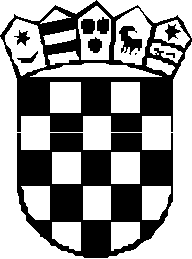 REPUBLIKA HRVATSKA KARLOVAČKA ŽUPANIJA GRAD KARLOVAC GRADSKO VIJEĆE KLASA
REPUBLIKA HRVATSKA KARLOVAČKA ŽUPANIJA GRAD KARLOVAC GRADSKO VIJEĆE KLASALOCK PARAMETERS DATE Z0 CDCL3 LOCK POWER LOCK
ANEXO II MODELO DEL LIBRO DE SUBCONTRATACIÓN CARACTERÍSTICAS DE
 CAMBIO № 1 ST RK 24312013 TRENES ARTICULADOS DE
CAMBIO № 1 ST RK 24312013 TRENES ARTICULADOS DEMITTEILUNG FÜR UMSATZSTEUERZWECKE ÜBER DEN INNERGEMEINSCHAFTLICHEN ERWERB EINES NEUEN
 OBSTACLE DETECTION ROBOT WITH MECHANICAL SENSING SWITCHES THE PURPOSE
OBSTACLE DETECTION ROBOT WITH MECHANICAL SENSING SWITCHES THE PURPOSEREGULAMENTUL PRIVIND ORGANIZAREA ŞI FUNCŢIONAREA SERVICIULUI RELAŢII EXTERNE PAGINA